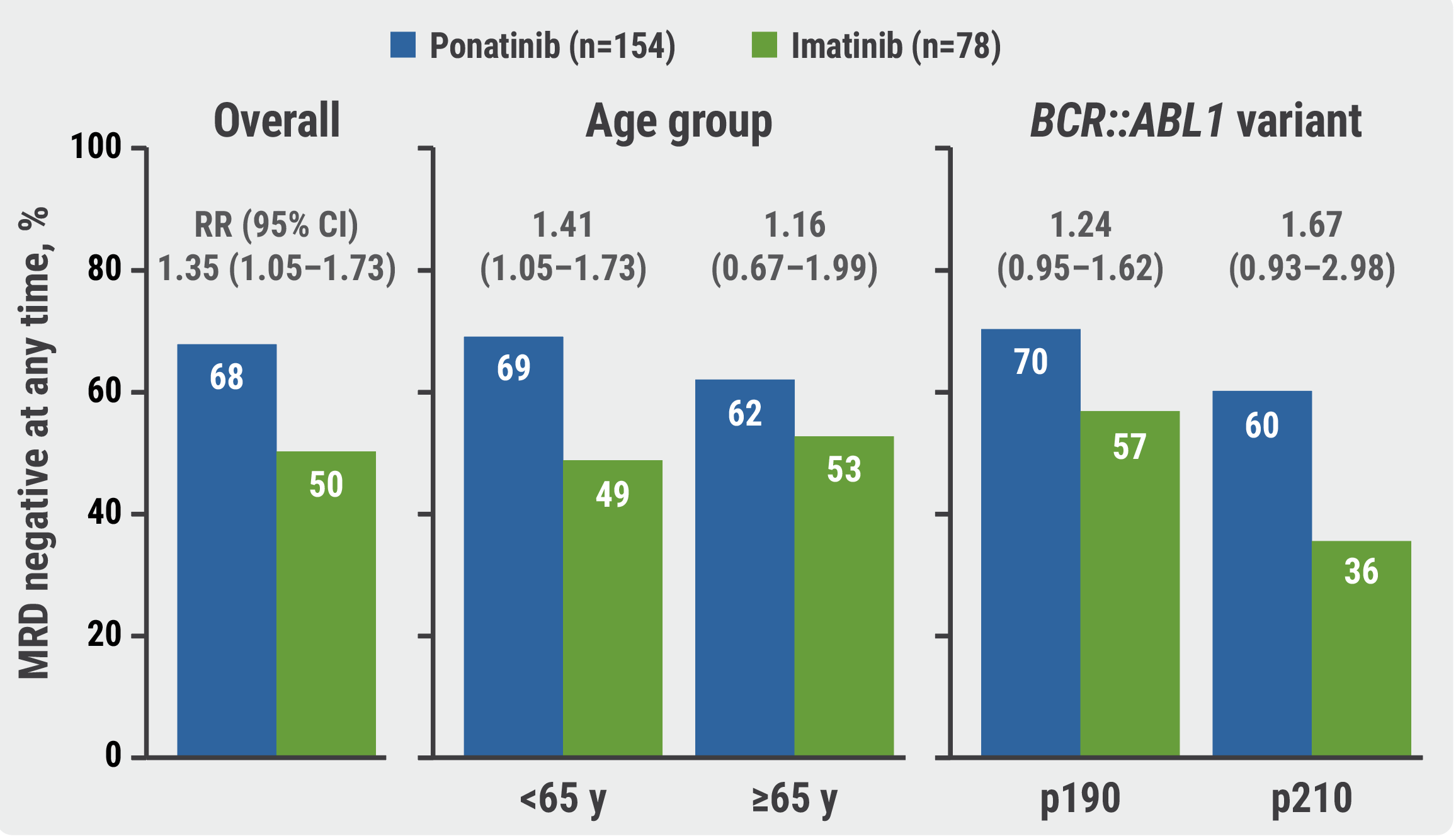https://doi.org/10.55788/3e2d036e
The phase 3 PhALLCON trial (NCT03589326) compared the third-generation BCR::ABL1 tyrosine kinase inhibitor (TKI) ponatinib to the first-generation variant imatinib in participants with newly diagnosed Ph+ ALL. Enrolled participants (n=245) were randomised 2:1 to ponatinib or imatinib plus reduced-intensity chemotherapy. A previous analysis demonstrated that the primary endpoint, MRD-negative clinical remission rate at the end of induction, favoured the ponatinib arm (34.4% vs 16.7%) [1]. In the current analysis, Prof. Jose Maria Ribera (Josep Carreras Leukaemia Research Institute, Spain) shared additional efficacy data, outcomes in subgroups, and results from participants who proceeded to stem cell transplantation [2].
After a median follow-up of 19.4 months, the median PFS was significantly longer for participants receiving ponatinib than for imatinib controls (20.2 months vs 7.5 months; HR 0.52; 95% CI 0.36–0.73). This result was consistent with the higher rates of participants who were MRD negative at any time in the ponatinib group, even when subdivided per age (younger or older than 65 years), and BCR::ABL1 subgroups (p190 or p210; see Figure). Fewer participants in the ponatinib arm proceeded to stem cell transplantation at any time (36% vs 47%). This finding was consistent in the MRD-negative subgroup of participants (32% vs 56%).
Figure: MRD negativity at all time rates for participants receiving ponatinib vs imatinib [2]

CI, confidence interval; MRD, measurable residual disease; RR, relative risk; y, years of age.
The safety profiles of the 2 agents were very comparable, although more participants in the ponatinib arm had dose interruptions due to unspecified reasons (73% vs 41%). “Of note, the exposure time was more than 2-fold longer in the ponatinib arm than in the imatinib arm among participants who did not proceed to stem cell transplantation, whereas the adverse event rates remained similar,” emphasised Prof. Ribera.
Additional data from the PhALLCON trial confirmed the superior efficacy of ponatinib over imatinib plus chemotherapy in participants with newly diagnosed Ph+ ALL. Also, the exposure-adjusted safety profile of ponatinib appears to be more acceptable than the imatinib profile.
- Jabbour E, et al. JAMA. 2024;331(21):1814–1823.
- Ribera J-M, et al. Ponatinib versus imatinib in patients with newly diagnosed Ph+ acute lymphoblastic leukemia in the phase 3 PhALLCON trial: in-depth responder analysis. S115, EHA congress 2024, 13–16 June, Madrid, Spain.
Copyright ©2024 Medicom Medical Publishers
Posted on
Previous Article
« APOLLO: ATRA plus ATO meets expectations in high-risk APL Next Article
Encouraging data for ELA026 to treat secondary haemophagocytic lymphohistiocytosis »
« APOLLO: ATRA plus ATO meets expectations in high-risk APL Next Article
Encouraging data for ELA026 to treat secondary haemophagocytic lymphohistiocytosis »
Table of Contents: EHA 2024
Featured articles
Meet the Expert: Prof. C. Ola Landgren discusses MRD as a key endpoint in haematological cancer trials
Multiple Myeloma
Isa-VRd proves its value in newly diagnosed MM in the IMROZ trial
PERSEUS: High MRD negativity rates with D-VRd and consolidation therapy and D-R maintenance in MM
Post-intensification data confirm superiority of quadruple therapy in MM
Promising phase 1 results for novel CAR T-cell therapy in MM
DREAMM 8: Belantamab mafodotin offers hope for patients with RRMM
Leukaemia
PhALLCON: Third-generation TKI superior to first-generation TKI in Ph+ ALL
APOLLO: ATRA plus ATO meets expectations in high-risk APL
Excellent phase 3 results for asciminib in chronic myeloid leukaemia
AUGMENT-101: Revumenib trial in KMT2Ar leukaemia stopped early for efficacy
FLAG-Ida plus venetoclax induces high MRD-negativity rates in AML
CD40/CD47 inhibitor shows promise in high-risk MDS and AML
ENHANCE: Magrolimab does not ameliorate health outcomes in high-risk MDS
Can MRD-guided azacitidine treatment improve outcomes in AML and MDS?
Can WGTS replace standard-of-care diagnostics in AML?
Non-malignant Haematology
ENERGIZE: Mitapivat meets primary efficacy endpoint in thalassaemia
Sovleplenib delivers durable responses and QoL improvements in primary ITP
Avatrombopag successful in children with chronic ITP
RUBY: Promising data for first AsCas12a gene-editing therapy in sickle cell disease
Encouraging data for ELA026 to treat secondary haemophagocytic lymphohistiocytosis
Myelofibrosis
Navitoclax plus ruxolitinib leads to spleen volume reductions in myelofibrosis
Is pelabresib plus ruxolitinib the paradigm-shifting combo therapy for myelofibrosis?
Lymphoma
The landscape of TP53 mutations and their prognostic impact in CLL
Can golcadomide plus R-CHOP become the first-line standard of care in high-risk BCL?
High survival rates following atezolizumab consolidation in DLBCL
First results for zanubrutinib plus venetoclax in del(17p)/TP53-mutated CLL/SLL
EPCORE CLL-1: Promising data for epcoritamab in high-risk Richter’s transformation
Updates from the EBMT Lymphoma Working Group: outcomes after allo- and auto-SCT for T-cell lymphoma subtypes
ECHO: Can we expect a novel standard of care in newly diagnosed MCL?
Clinically meaningful outcomes for mosunetuzumab across follicular lymphoma subgroups
Related Articles
© 2024 Medicom Medical Publishers. All rights reserved. Terms and Conditions | Privacy Policy
HEAD OFFICE
Laarderhoogtweg 25
1101 EB Amsterdam
The Netherlands
T: +31 85 4012 560
E: publishers@medicom-publishers.com

